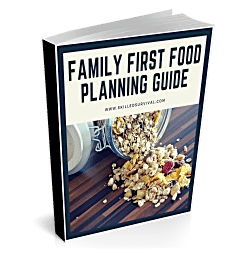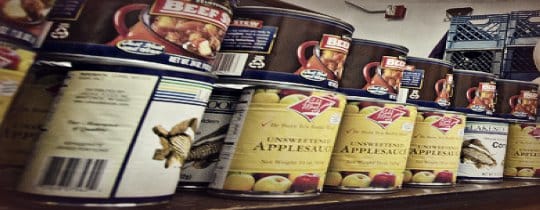
Because if you want to get prepared fast, you’ve got to know your non-perishables like a squirrel knows its nut stash.
- What exactly are they?
- Why are they so important?
- Where do you find the best ones?
- And which ones should you actually stock up on?
Skip this step, and you might end up with a pile of questionable canned mystery meat instead of a survival stash you can rely on:
What Is Non-Pershiable Food Anyway?
They’re foods that:
Remain stable and safe to eat for long time that don’t require refrigeration.
We all know different foods spoil at different rates.
Dairy products (such as milk and eggs) will spoil quickly if left out on the counter (unless you use shelf stable milk, canned coconut milks, or dehydrated eggs).
While a granola bar might last several weeks with no ill effects.
The point is:
There are extremes in food spoilage rates, and non-perishable items are on the far end of the spectrum.
The further out, the less perishable it is.
Now, technically no food is truly shelf stable FOREVER.
Eventually, all foods will become spoiled, rancid, or lose flavor.
Bacteria will eventually decompose all organic matter.
It feeds off calories just as we do.
It changes food’s taste, color, and smell, creating foodborne illnesses if ingested.
Sure, with the help of technology, food may last several decades.
But don’t expect anything to last much longer than that.
↓ 20 Foods To Stockpile That NEVER Expire ↓

Want a free family-first food planning guide?
Enter your email below to instantly download this Complete Guide PDF. No purchase necessary. 👇 👇Reasons Why You Should Buy Non-Perishable
Now that you know what they are, you may wonder, so what?
We have refrigeration.
Yes, we do – most of the time.
Emergencies
But what happens when the power goes out for a few days or weeks?
Those frozen steaks, cartons of eggs, and your head of lettuce are in serious trouble.
And once those turn for the worst – you’ll be glad you kept some shelf-stable foods in your stocked pantry.
They’re a staple within the broader category of survival food kits.
That’s why here at SkilledSurvival, we tend to focus on stockpiling food for emergencies and basic prepping.
↓ How To Start A Prepper Food Pantry ↓
But there are other reasons to invest in non-perishable foods:
Camping
Sometimes it’s worth buying some for a camping trip.
Why? Because you can avoid dealing with a cooler and melting ice.
Whenever I take my cooler camping, we buy lunch meat and brats for our camping meals.
And the ham slices and brats start swimming every time the ice melts.
Creating a gross raw meat cesspool.
Instead, you can avoid this fiasco by choosing non perishable meat – like Beef Jerky.
Travel
Sometimes, it’s easier to avoid the hassles of cooking altogether.
One example of this is if you are backpacking or traveling.
These foods prevent you from building a fire or taking a portable stove.
This can help save weight or space.
Plus, you are normally exhausted from backpacking by the end of the day.
You want to set up camp, eat, relax, and go to bed.
So why not make the feasting process as simple and effortless as possible?
It’s a chore to cook a meal when your energy is depleted, and your tummy is rumbling.
For Donation
A food bank will ask specifically for “non-perishable food items.”
They need foods they can stockpile, transport, and serve without refrigeration.
Can you imagine feeding thousands of homeless people fresh salads?
It would spoil before they could serve it…
One of the staples of food donation is canned foods – they are always a wise gift.
But I encourage you not to give canned food you’ve never eaten because it’s gross.
Donate tasty and healthy canned foods!
So avoid sending them your cans of “Creamed Possum in Coon Healthy Fat Gravy Garnished with Sweet Potatoes” – Yuck!
Reduce Waste
And here are some food waste statistics to consider:
- Approximately 1/3 of worldwide human food production is wasted every year (about 1.3 BILLON tones)!
- Food losses and waste add up to about $990 billion globally.
- Fruits and vegetables have the highest rate of waste of any food type.
- North American and European consumer waste is between 210 and 250 lbs. per person annually!
- 842 MILLION people do not have enough food…about 12% of the world’s population!
So by eliminating waste, we can help to reduce much of our world’s starvation.
Essentially – good food preservation can help to reduce this unnecessary waste.
List Of Non-Perishable Foods
A list of non perishable foods including:
- Beef Jerky
- Granola Bars
- Dried Pasta (ramen noodles, macaroni, spaghetti, etc.)
- Trail Mix (especially the nuts)
- Dry Rice and Dried Beans (here’s our article on stockpiling rice)
- Canned Veggies (corn, green beans, beets, carrots, tomatoes, etc.)
- Canned Fruits (cherries, peaches, etc.)
- Canned Meats (salmon, chicken, beef, etc.)
- Freeze-Dried Meals (here’s our article on freeze-dried foods)
- Oatmeal
- Nut Butter (here’s our article on powdered peanut butter)
- Apple Sauce
- Coffee Beans
- Pancake Mix
- Sugar
- Syrup
- Vegetable Oil
- Crackers (hardtack) – (here’s our article on How To Make Hardtack)
- MREs – (here’s our article on MREs)
- Pemmican – (here’s our article on How To Make Pemmican)
- Powdered Milk
- Dried Fruits (here’s our article on How To Dehydrate Fruit)
- Most Dry Spices
↓ Top Forever Foods For Survival ↓

Want a free 78 item preppers checklist?
Enter your email below to instantly download this Complete Checklist PDF. No purchase necessary. 👇 👇Where To Buy Non-Perishable Foods
You can get many of these foods from your local grocery store.
Peanut butter, crackers, honey, etc., are all readily available to pull off the shelf.
But one type of food that is more difficult to find at the grocer is Freeze Dried Foods.
Specialty manufacturers make these.
But you won’t find a wide selection of freeze-dried foods in your local grocer.
They sell them at sporting goods stores or online.
So why invest in freeze-dried foods?
Because they ARE the best food for survival and preparedness!
But freeze-drying yourself is time-consuming and cost-prohibitive.
It’s best to find deals online.
We’ve put together several reviews for you to get started.
I’ve personally used all three brands for my stockpile.
Each company has pros and cons, but they are all reputable.
So compare and then buy a meaningful amount.

Want a free family-first food planning guide?
Enter your email below to instantly download this Complete Guide PDF. No purchase necessary. 👇 👇How To Make Perishable Foods Non-Perishable
Making food non-perishable boils down to reducing bacteria’s ability to grow.
Bacteria is an organic entity; it’s alive.
So it has basic survival needs (not all that different from ours).
Bacteria needs:
- Mild, Room Temperature Ranges
- Air (oxygen)
- Moisture (water)
- Food
We obviously can’t block the last item on the list – Food.
Why? Because food is what we are trying to protect.
Eliminating the food source defeats the purpose!
But if you block any of the others, you reduce bacteria’s evil plans to spoil your food.
Temperature Control
Most of us currently prevent food spoilage every day using refrigerators and freezers.
Cold temperatures reduce bacteria’s ability to survive or thrive.
In freezing cold temps, it dies.
In cooler dry temps, it can survive but is weaker and doesn’t thrive.
Side Note:
There were root cellars and iceboxes before refrigeration.
Not convenient, but the principles were the same.
Lower temperatures preserve food.
Suffocation
Another way to combat food-spoiling bacteria is to remove oxygen.
Bacteria need oxygen to survive.
So you can separate the food from oxygen by using vacuum sealing, oxygen absorbers, and/or Mylar bags.
Remove The Moisture
Finally, bacteria need water (i.e., moisture) to survive.
If you remove most or all the moisture in food, bacteria will not spoil it.
However, there is a big difference between dehydrated foods (reduced moisture) and freeze-dried food (near zero moisture)…
So let’s review a few more conventional ways to reduce bacteria growth.
Canning
Putting your extra garden produce in a can is one time-tested way to preserve food.
Canning is putting veggies into sealable cans with liquid, heating, and cooling to create a vacuum (i.e., no air).
Why? Because, just like us, bacteria need air to survive.
So, without oxygen, bacteria cannot survive to destroy your canned foods.
Freeze Drying
Freeze-drying food is a process that removes nearly all the moisture from food.
But does so in a way that doesn’t damage the food.
Remember, moisture is a key ingredient for bacterial growth.
So by removing all moisture, you’re eliminating bacterial growth in the food.
Freeze-drying leaves the food in a state willing to accept and reconstitute moisture.
Usually, you need to add liquids to the food and allow it to reabsorb moisture.
With some non perishable meals, you add boiling water to reconstitute and cook the food.
However, freeze-drying on your own is either complex or expensive.
If you try to make your own freeze dryer – it will be a complicated engineering project.
Yes, it CAN be done but at the cost of time and energy.
The other way to make your own freeze-dried food is to buy a home freeze-dryer.
Harvest Right is the leader in this home freeze-drying industry.
So, buying a Harvest Right freeze drier makes sense if:
- You have a lot of extra money to spend
- Or do you know a large group of people who want to share the expense and the machine
- Or you want to start your own small freeze-drying business
If you agree with any of those options, you SHOULD check out Harvest Right Start by watching the video below:
↓ How Your Harvest Right Freeze Dryer Works ↓
For everyone else, I recommend buying freeze-dried foods instead.
You should check out Valley Food Storage, Legacy Emergency Foods, or Mountain House.
Why? Because you can buy a whole lot of prepackaged freeze-dried food for the several grand, it takes to own your own freeze-drier!
Dehydrating
Dehydrating is somewhat similar to freeze-drying but is not nearly as effective.
Both reduce moisture but in vastly different ways.
Instead of using vacuum chambers and dried ice, you use heat and air movement to remove moisture.
The combination of heat and air dries out the food.
And again, lack of moisture is one proven strategy to halt or reduce the spoiling process.
As good as this sounds – dehydrating is not nearly as effective as freeze-drying.
Sure, you can turn a perishable apple into dried apple chips.
It’s better than nothing and will prevent bacterial growth.
But dehydrated foods won’t last decades like freeze-drying.
Freeze Drying VS Dehydrating
One way to think about dehydrating vs. freeze-drying is to compare it to a Refrigerator vs. a Freezer.
A refrigerator slows bacterial growth but doesn’t eliminate it.
A freezer eliminates bacterial growth.
So dehydrating is like refrigeration (slows the growth), while freeze-drying is more like a freezer (eliminates all growth).
But freeze drying is BETTER than freezers because it doesn’t need a constant flow of electricity!
So freeze-drying is preferred for extremely long shelf lives – it’s the ultimate survival and preparedness food.
Back to dehydrating:
It’s both easy to do yourself and affordable.
You can start dehydrating fruits and vegetables today using tools you own.
All you need is:
- A conventional oven (low heat – crack the door open)
- A food dehydrator, or
- A DIY backyard dehydrator (using wind and sun)
↓ Dehydrating For Food Storage ↓
Excellent “How-To” Preserve Resource
I want to share one of the best resources.
It’s a book of old-school “lost” food preservation techniques.
It includes forgotten foods used before refrigeration!
It’s called “The Lost Ways.”
This book includes step-by-step instructions on Lost Techniques, such as:
- How To Make Pemmican (a longer shelf life meat invented by Indians)
- How To Build A Self-Feeding Fire
- Plus so much more…
If these “lost” frontier living techniques interest you (or someone you know) – click here to learn more.
It’s an excellent book to add to a survival library.

Want a free 78 item preppers checklist?
Enter your email below to instantly download this Complete Checklist PDF. No purchase necessary. 👇 👇Healthy Non-Perishable Foods
Some foods are healthier than others.
For example:
MRE (meals ready to eat) are NOT known for their health benefits.
They’re packed with calories to give soldiers plenty of energy.
But if you eat MREs without exercising, don’t be surprised if you pack on the pounds.
Soups have a lot of sodium – so try not to eat canned soup for every meal!
Nuts (like Almonds) are very healthy for you.
Beans are a healthy form of protein.
Canned vegetables are not the same as fresh fruits and veggies.
But they’re still a healthy non-perishable food item.
They’re a source of vitamins and minerals.
The bottom line:
Proteins and veggies are the healthiest foods.
Avoid including much added sugars or sodium.
Keep your stockpile healthy by making wise choices.
↓ Unhealthy Vs. Healthy Snack Foods – Mind Over Munch ↓
Non-Perishable Food For Hurricane Prep
People ask about food related to hurricanes.
Why hurricanes and not other emergencies?
I think it’s because hurricanes are natural disasters you see coming days ahead.
So when a hurricane becomes a reality, people start researching non perishable food options.
Other emergencies happen fast and unexpectant – like tornados, earthquakes, wildfires, etc.
You don’t have advanced notice for these disasters…
That said, food for hurricanes is no different than any other emergency.
Calories are calories when the grocery stores are bare.
But you should add a few extra cans of spinach (like Popeye) if you need the strength to weather the storm.
Otherwise, any foods in the above examples will do for your hurricane prep list.
Just make sure you keep your survival foods in a safe, secure location.
If the hurricane destroys your house and your food is in your upstairs pantry – it’s gone!
So try to store your prepper food in a basement, unless flooding is possible.

Prepare, Adapt & Overcome,
P.s. - I just found out 2 out of 3 Americans don’t feel prepared for a 3 day disaster!!!
I guess this goes to show how modern society continues to embrace ‘living a fragile life.’ What’s crazy is… it’s so easy to fix.
To make sure YOU have the basics, watch our FREE training on “10 Simple Steps To Basic Preparedness” that shows you HOW.
Nothing crazy here… this isn’t doomsday prepping... just the basics every responsible adult should have before a disaster strikes.Why You Can Trust Skilled Survival...
Go here now to review a full breakdown of:
- Who We Are
- Our Credentials
- Our Mission
- & Product Recommendations...
Here are a few highlights of our teams credentials & certifications:
- Certified Member of a Mountain Search & Rescue Organization
- Plant Emergency & Safety Leader for a Major Food Manufacturer
- Member of the 10TH Mountain Division Hut Association
- Certifications: Avalanche 1, WFR, CPR
- Official Gear Tester for Numerous Outdoor Gear Companies
- Countless Multiday Backpacking trips into Remote Wilderness
- Bachelor's Degree In Mechanical Engineering
- Bachelor's Degree In Civil Engineering
- Bachelor's Degree In Biomedical Engineering
"It takes 20 years to build a reputation and five minutes to ruin it." - Warren Buffett
We're fully aware that trust is NOT something you GET but is EARNED.
And we'll continue to earn YOUR trust through our forthright and honest approach with each new Blog Post, Guide & Product we create...
P.s - I just took this FREE 60-second 'Readiness Score Quiz'👇
AND... I've still got a few gaps in my preps...🤔 But at least, I'm not part of 'The Fragile Masses'. 👍 Find out where YOU stand by answering a few questions...

Recommended Reading
Emergency Food Storage When Calories Become Scarce
Building your emergency food storage doesn't have to be complicated. We break things down into simple steps to help you do it right.
The Most Nutritious Survival Foods You’ll Actually Love
What are the best survival foods? It depends on your goals. We look at different scenarios to help you stockpile the best emergency foods.
Dehydrating Fruit: How To Preserve Sweet Calories
Dehydrating fruit is a great way to store tasty calories for long-term storage. We should you the best way to dehydrate some for emergencies.
Unique Food Storage Ideas: The Most Surprising Locations
Want a large emergency food stockpile but living in cramped quarters? Don't let this ruin your preparedness passion! Try these unique food storage ideas.
Prepper Food: Best Ones to Stockpile For Emergencies
What's the worst-case scenario if you choose NOT to stockpile any food? Starvation. That's why investing in prepper food is so wise.
Valley Food Storage Review: An Expert Puts It To The Test
Unbiased and thorough Valley Food Storage review covering food supplies, packaging, taste, and shelf life. Don't buy without reading this...







